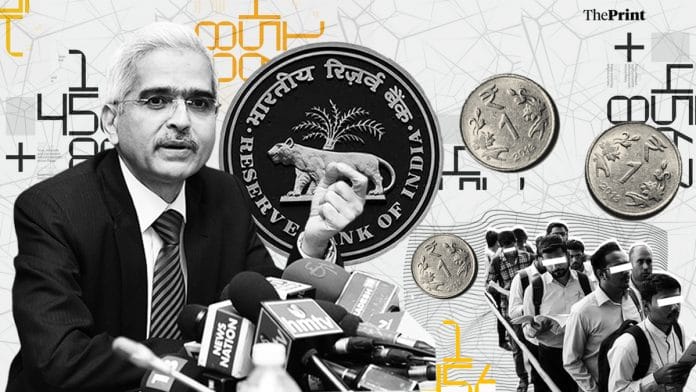The RBI’s Monetary Policy Committee Thursday stunned economists and market analysts by retaining the key interest rate at 5.15 per cent after pushing through five consecutive rate cuts since February. The RBI also kept the reverse repo rate unchanged at 4.9 per cent while lowering its GDP growth forecast for FY20 to 5 per cent from 6.1 per cent.
ThePrint asks: Is RBI right in not cutting interest rate even as it downgrades growth forecast to 5%?
RBI’s decision is driven by the rise in vegetable prices, which monetary policy response can’t tackle
 Radhika Pandey
Radhika Pandey
Fellow, National Institute of Public Finance and Policy
Contrary to a near-consensus on a 25 basis points cut in the policy rate, the Monetary Policy Committee in its Thursday’s review chose to take a pause. The key factor driving the MPC’s decision is the spurt in vegetable prices: in particular, onion prices. The MPC projects the vegetable prices to start moderating from February 2020. These prices are seasonal in nature, and they spike every year around this time.
Rather than a monetary policy response, better supply-side management measures in the form of storage, distribution and timely imports are required to tackle the seasonal spike in vegetable prices. There is little that interest rates can do to counter inflation, which is seasonal and supply-driven.
The MPC is of the view that the 135 bps rate cut needs some time to show its effect. This implies that interest rate decisions operate with a lag. Keeping interest rates unchanged at this point will probably have an impact over the next two quarters. By then, food prices would have fallen with fresh supplies hitting the market.
The key indicator of demand — the core inflation — remains subdued. There is little that the MPC can do other than drastically cut rates to stimulate demand at a time when high-frequency indicators point to weak demand. Financial sector reforms to improve monetary policy transmission have to be carried out in tandem.
Views are personal.
RBI should have cut interest rates further. Its task is to target inflation, mindful of growth
 Ila Patnaik
Ila Patnaik
Economist and a professor at the National Institute of Public Finance and Policy
The Monetary Policy Committee of the Reserve Bank of India has decided to hold interest rates unchanged, a view that has surprised the markets. The RBI’s task is to target inflation, mindful of the objective of India’s economic growth. Since the growth forecast for FY20 has come down to 5 per cent, and as the increase seen in the inflation rate has really been the increase in food inflation, it was expected that demand would keep inflation projections down, and thus there was a strong case for a rate cut.
The RBI has said that it wants to wait and watch the effect of the cut of 135 basis points already made so far in 2019. The case for a rate cut comes from the sharp slowdown in demand. The projection for core inflation has remained unchanged. Even though the inflation target is the Consumer Price Index, since that is the rate that households can relate to, central banks make decisions about rates using the core inflation rate that excluded volatile food prices.
Food price inflation has short-term and seasonal determinants. There has been a lot of research into whether an increase in food inflation should determine repo rate. Since monetary policy can impact inflation in about 6 to 8 quarters, short-term food price changes that are not expected to persist do not feed into monetary policy decisions. Considering these factors, the RBI should have cut interest rates further.
Views are personal.
RBI knew growth wouldn’t have picked up after its last rate cut and so took the decision accordingly
 Abhijit Sen
Abhijit Sen
Former member of the Planning Commission of India, professor of economics at JNU
I am not sure why the RBI is doing this. Although, it is not unusual for the RBI to go only by growth forecasts while deciding the interest rates.
It is probably the correct thing to do because interest rates have been cut quite considerably in the recent past. Knowing that the economic growth is unlikely to have picked up from when it last cut the interest rate on 4 October, I am sure the RBI factored it in when it took the decision Thursday. The extent to which interest rate cuts can affect growth at this point is rather limited.
Moreover, food inflation is a bit erratic and there shouldn’t be any concern about cereal inflation but other items like fruits and vegetables have been erratic due to climate reasons. The recent rise in prices of certain goods may scare the RBI, but it should not feed into interest rate accounting.
Growth rate must be kept above everything else only if the RBI thinks that cutting interest rates is going to increase growth. If that it is not going to happen, then cutting interest rates does nothing. The RBI could, in that case, try other measures like shoring up the banks on their liquidity position and balance sheets.
RBI would like its transmission policy to play out after the linking of bank lending rates with repo rates

Ajay Bodke
CEO (PMS), Prabhudas Lilladher Pvt Ltd
The RBI’s decision to not cut the repo rate is a prudent stance given the present circumstances. The RBI has kept its monetary stance accommodative and held out hope of cutting the rate if the situation so warrants.
The spike in consumer inflation forecast is essentially due to the sharp rise in food inflation, which is transitory in nature, with a delayed monsoon impacting the khari arrivals. With record high reservoir levels and good soil moisture content, rabi production is expected to be bumper and that should help alleviate concerns about food inflation along with swift measures being adopted by the Narendra Modi government to import onions.
More importantly, core inflation remains well within the RBI’s comfort zone. The cut in GDP growth forecast for FY 2019-20 was on expected lines, but there is a silver lining here too. The pace of transmission should pick up steam with the RBI now linking bank lending rates directly with the repo rates from 1 November 2019. Hence, it is understandable that the RBI would like better transmission to play out. The RBI’s monetary measures and the Modi government’s fiscal measures should work in tandem to revive the slowing economy impulses.
Moreover, the RBI Act, 2019 has clearly specified that the RBI’s primary objective is to ensure price stability, which is its biggest concern. But the RBI also cannot be oblivious to growth imperatives, which is why governor Shaktikanta Das has emphasised that the RBI’s focus is to work in tandem with the fiscal authorities to revive economic growth.
Indian economy is facing an overall policy neglect. Rate cut by RBI can be of very little help

Praveen Jha
Professor, Centre for Economic Studies and Planning, JNU
The RBI should try and ease the scenario by cutting down interest rates, although I don’t think it will be enough. A major concern here has to do with a comprehensive analysis of this extremely difficult issue, which has come about for a variety of reasons ranging from structural to policy assaults in the overall system.
It is perhaps for the first time since India’s independence that consumption has fallen to this extent. There is a huge distress in rural areas, mainly caused by demonetisation and the Goods and Services Tax (GST).
Apart from an overall policy neglect, we are dealing with several serious issues. RBI rate cuts can be of very little help. But some easing must be welcomed, provided the cut is translated into lending through the chain. Sometimes, the RBI eases interest rate and benefits are not passed on. It is only the well-off now who managed to get benefits out of these rate cuts.
Moreover, food inflation has very little to do with a minor rate cut. Why can’t the authorities fix the overall provisional chain for onions?
I am all for easing, but rate cuts are like applying a band-aid on someone with a terminal disease. Relying on rate cuts is plain foolishness. This is just a bogey and will have an impact on inflation.
Also read: RBI needs to take unconventional steps as rate cuts aren’t helping economy: Bond manager
By Kairvy Grewal, journalist at ThePrint







RBI has reduced rates as many times , as if that prescription will help cure the economic health.
It is like the case of a doctor experimenting with his prescriptions with the patient, unsure of his diagnostic approach.
RBI has to play a more proactive and advisory role for effective economic health and put out the rationale of its thinking
to show that it is in keeping with the the sound Economic and Financial principles.
Rate cuts have become a one trick pony, at a time when no sensible ideas on reviving the economy are on the table. I would welcome today’s pause if for no other reason than that the RBI and its MPC should be widely seen to have a PoV other than what is conveyed over the phone from North Block. The Governor is facing the real world. Inflation – the only saving grace of the last few years – edging up. The INR under pressure.
If you are over sixty, and depending on interest income for your living, you would know that everytime RBI reduces interest rates, the Banks reduce interest rates on FDs. Ours is a situation where middle class has to support rich businessmen by sacrificing their interest earning.